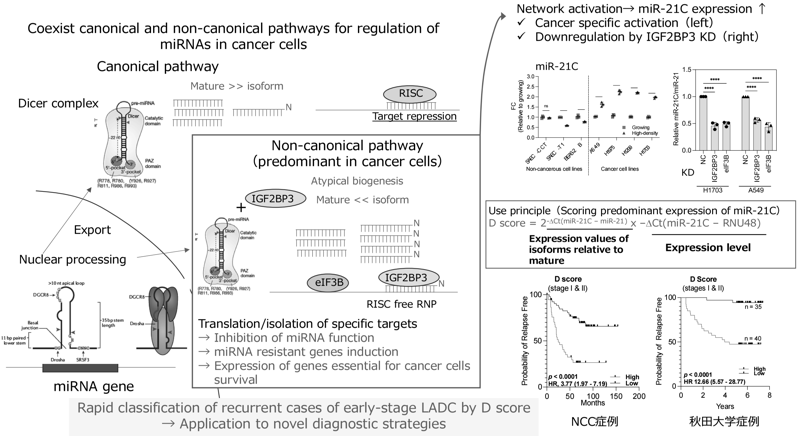Annual Report 2021
Molecular Carcinogenesis Unit
Naoto Tsuchiya, Yuko Fujiwara, Daiki Yamamoto, Takahiro Shirai, Yuma Takamoto, Hyato Mikuni, Yumi Miyamoto
Introduction
To understand the nature of cancer, it is essential to clarify the network structures that are established during the carcinogenesis process. Our research unit is conducting fundamental research to elucidate the intracellular network formed in cancer cells by analyzing non-coding RNAs and to establish new strategies for cancer therapy and diagnosis by analyzing cellular, animal, and surgical specimens.
Research activities
(1) Understanding a novel miRNA regulatory pathway and its application as a diagnostic biomarker
We are conducting basic research to understand the full scope of post-transcriptional gene silencing (PTGS) by miRNAs, to elucidate the mechanism of action for changes in gene expression profiles during carcinogenesis. We are also conducting fundamental research to create new cancer therapies based on the principles of PTGS. In this fiscal year, we found that miRNA-based PTGS has non-canonical pathways in addition to canonical pathways, and that while balance between these pathways is necessary for regulation in normal cells, the activation of non-canonical pathways is found in cancer cells. Activation of the non-canonical pathways also affects the biosynthesis of specific miRNAs, leading to increased expression of structural isoforms in the cell. By scoring the expression predominance of those miRNA isoforms, we can efficiently identify high-risk groups for recurrence of early-stage lung adenocarcinoma. High-scoring tumors exhibit a mutator phenotype due to increased DNA replication and chromosome segregation, a high risk of recurrence due to micrometastasis induction by sustained epithelial-mesenchymal transition (EMT) pressure, and tumor characteristics with an immune evading microenvironment. Using this principle, we started to study practical application as a diagnostic marker for recurrence risk of early-stage non-small cell lung cancer by rapid identification of tumor characteristics.
On the other hand, we have also identified candidate molecules that play key roles in non-canonical pathway regulation, and are investigating how miRNA regulation by these molecules induces cancer cell-specific gene expression profiles (Figure 1).
(2) Regulation of tumor cells and tumor-microenvironment by miRNA secretion
Cancer cells secrete various factors to regulate the surrounding microenvironment (TME). miRNAs are released from cancer cells, encapsulated in extracellular vesicles and are essential for the maintenance of tumor tissue characteristics by regulating TME. On the other hand, it is also possible that the secretion of specific miRNAs regulates the properties of the tumor cells themselves, but this point has not yet been fully analyzed. In our findings, sarcoma cells were suggested to induce metastasis by secreting specific miRNAs when they are in a low nutritional state. We have also identified an intracellular factor that regulates this. That is, the secretion of specific miRNAs contributes to the determination of malignant properties of tumor cells. CMTM6, its intracellular target, has been reported to be associated with intracellular recycling of PD-L1, but other details on its functions are not known. We found that CMTM6 is a very important molecule that is involved in the intracellular trafficking of proteins that are components of plasma membrane raft structures, is crucial for the activation of plasma membrane receptor signals, and also regulates the secretory pathways of signaling molecules. We are also investigating drug delivery systems for treatment with nucleic acid medicine targeting this molecule.
(3) Development of miRNA-based recurrence prediction markers
The expression predominance score of the structural isoform of a specific miRNA discussed in (1) can be applied to other cancers, and we are considering applying it to colorectal and gastric cancers.

Education
Supervising research and presentation skills for graduate school students and young scientists.
Future Prospects
The results of this year's study are strongly expected to lead to proposing a new concept of functional abnormalities of miRNA regulatory networks in carcinogenesis. In addition, by applying the principle, it will be possible to develop a rapid and simple diagnostic method that can classify the risk group for recurrence of early-stage lung adenocarcinoma. In addition, since activation of non-canonical pathways strongly reflects tumor characteristics, they can be applied as biomarkers to assist in the formulation of treatment strategies for personalized cancer care. Furthermore, the extremely interesting findings on the significance of extracellular secretion of miRNAs are expected to further develop our understanding of the nature of cancer.
